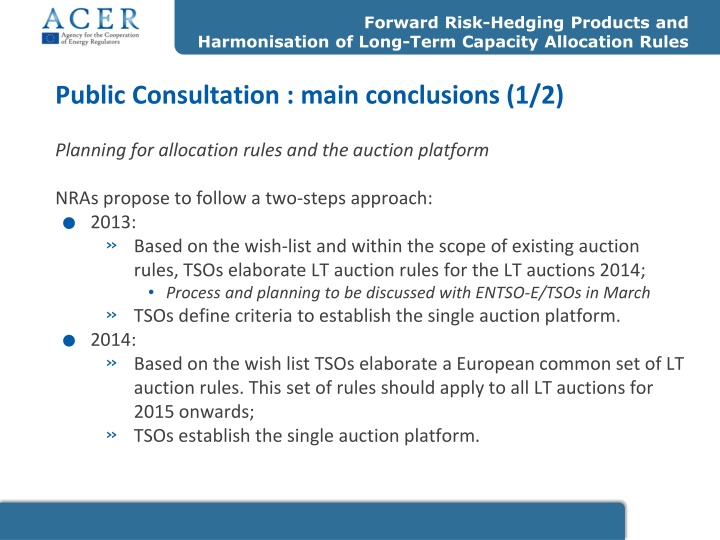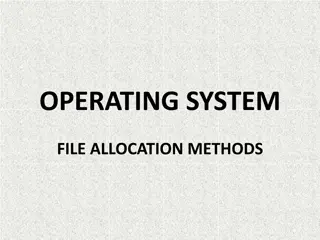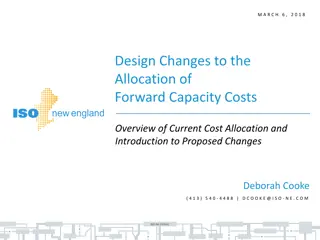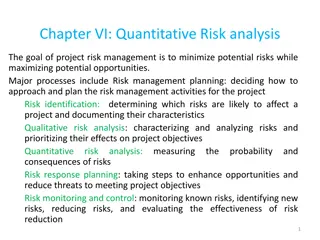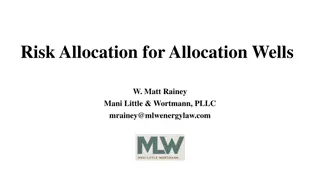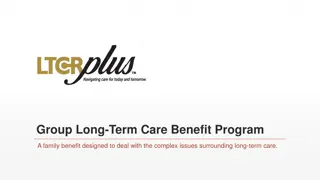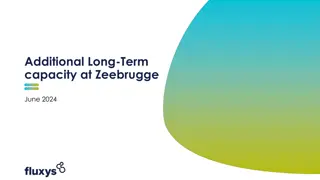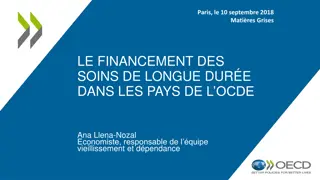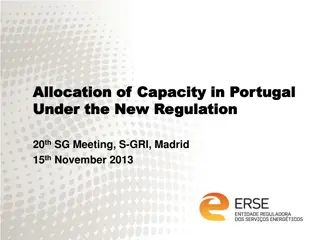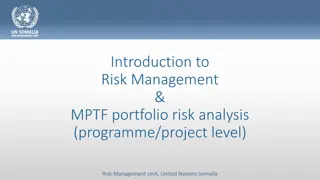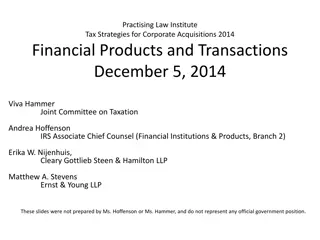Risk-Hedging Products and Long-Term Capacity Allocation Rules Public Consultation Conclusions
This document summarizes the main conclusions from a public consultation regarding risk-hedging products and harmonization of long-term capacity allocation rules, focusing on planning for allocation rules and the auction platform.
Download Presentation

Please find below an Image/Link to download the presentation.
The content on the website is provided AS IS for your information and personal use only. It may not be sold, licensed, or shared on other websites without obtaining consent from the author.If you encounter any issues during the download, it is possible that the publisher has removed the file from their server.
You are allowed to download the files provided on this website for personal or commercial use, subject to the condition that they are used lawfully. All files are the property of their respective owners.
The content on the website is provided AS IS for your information and personal use only. It may not be sold, licensed, or shared on other websites without obtaining consent from the author.
E N D
Presentation Transcript
Forward Risk-Hedging Products and Harmonisation of Long-Term Capacity Allocation Rules Public Consultation : main conclusions (1/2) Planning for allocation rules and the auction platform . 2013: Based on the wish-list and within the scope of existing auction rules, TSOs elaborate LT auction rules for the LT auctions 2014; Process and planning to be discussed with ENTSO-E/TSOs in March TSOs define criteria to establish the single auction platform. . 2014: Based on the wish list TSOs elaborate a European common set of LT auction rules. This set of rules should apply to all LT auctions for 2015 onwards; TSOs establish the single auction platform. NRAs propose to follow a two-steps approach:
Forward Risk-Hedging Products and Harmonisation of Long-Term Capacity Allocation Rules Public Consultation : main conclusions (2/2) Complementary studies . The Agency will investigate further the potential barriers to the Internal Electricity Market of having different mechanisms for the longer timeframe. . The impact of introducing longer-term products, . The introduction of buyback possibilities. The contributions raised the importance of assessing TRs impact on the liquidity of both forward and day ahead markets and benefits with FTRs compared to PTRs. In addition, it is mentioned both in the conclusions and the wish-list that, by the end of 2013, TSOs/ENTSO-E should provide a feedback and costs / benefits analysis on:
Forward Capacity Allocation Network Code Main issues Main issues in the draft FCA NC as of 17 Jan 2013 (Art 40) Clarification on the process to determine whether TR should be allocated Where TRs are already allocated, no need to decide on whether appropriate cross-zonal financial hedging is offered Where NRAs consider that appropriate hedging tools are offered, no need to decide not to allocate TR / they may decide the TSOs not to allocate TRs (check legal robustness), and then other articles do not apply Review of this decision only at the initiative of NRAs or upon request of SOs (Art 2 & 46) Revenue Adequacy principle Concept not foreseen in the FG Implication for UIOSI ? (Art 67-70) Firmness Use of LT Firmness Deadline ? Compensation principles not in line with the FG Reimbursement of Initial Price Paid : only in case of force majeure in the FG Capped Market Spread-Based Compensation : only before nomination (or LF Firmness deadline) (Art 44 & 45) Process and deadlines for platform(s): 3 years ? Definition for the common set or requirements (6 months) + NRAs approval (6 m) + Decision (12 m) + NRAs approval (6 m) + Establishment (12 m)
Forward Risk-Hedging Products and Harmonisation of Long-Term Capacity Allocation Rules Public Consultation: main conclusions (1/2) . On the types of products, the replies to the public consultation reflect the differences between: The Nordic electricity market model Price hedge (through CfDs) No PTR / Physical delivery through the Day ahead market The continental models Allocation of TRs by TSOs No clear-cut outcome TRs desired (except in the Nordic region) Preference for PTR Issues regarding FTR . Main conclusions: would be worth studying the impacts on liquidity of the day-ahead and forward markets
Forward Risk-Hedging Products and Harmonisation of Long-Term Capacity Allocation Rules Public Consultation: main conclusions (2/2) . Wish list General support of the wish-list A few points to be clarified Issues to be adressed in the NC, e.g. : firmness approval and amendments procedures application of UIOSI or pay-out of capacity products definition of force majeure . Harmonisation of LT capacity allocation rules Products: longer term requested Secondary market: buy-back possibilities for TSO Auction platform: volontary process with deadline and one single auction platform . Main conclusions: requesting TSOs to study longer- term products + buyback (with caps )
Forward Capacity Allocation Network Code Other issues Other issues in the draft FCA NC as of 17 Jan 2013 Clarification of the objectives of the code (used as a criteria for some requirements) Process to elaborate and approve rules (separate requirements, rules, firmness ) : complicated Best / reasonable endeavours to be removed (as recommended in CACM NC) (Art 7 et seq.) NRAs approval : all/each? considering also consequences of article 40 (Art 29, 34 & 35) Clarification on the methodologies for capacity calculation and LT volume determination, including specifications on the splitting rules across timeframes and volumes allocated in yearly auction, and on validation process Capacity calculation : adaptations may be necessary to be in line with ACER s requests on CACM (Art 80 et 81) Transitory measures: only for Platforms in the FG (not for HAR and firmness)
Forward Capacity Allocation NetworkCode Revenue Adequacy Revenue Adequacy in the draft FCA NC as of 17 Jan 2013 . (Art 2) Revenue Adequacymeans the condition that links the LTR payouts to the collected Day Ahead congestion income in order to mitigate the risk to System Operators of adverse financial deficits due to specific design aspects of Day Ahead Capacity Allocation such as, but not limited to, adverse flows, losses; Concept not foreseen in the FG Only link the LTR payout and the collected Day Ahead congestion income; not applicable to firmness? (+ the Long Term auction revenue?) Implication for UIOSI ? It is not clear that firmness will be guaranteed for the capacity as stated in the Framework Guideline. To what extent Revenue Adequacy is different from cost recovery? Framework Guidelines (Art 4.2) claim that : . nomination (or equivalent market allocation process), which means, as a default, the resale of non- nominated capacity rights. TSOs shall give the total financial resale value of capacity (in the case of an explicit auction this is equal to the clearing price of the auction in which the capacity is resold; in the case of an implicit auction this is equal to the day-ahead price differential between the two zones) back to the market participants who owned the PTR. The FCA Network Code(s) shall require that PTR are subject to the UIOSI requirement at the time of
Forward Capacity Allocation Network Code Firmness Firmness in the draft FCA NC as of 17 Jan 2013 Issues to be discussed in the FCA : What is the LT Firmness Deadline for ? As compensation principles are defined for the period before the DA Firmness Deadline in the FCA NC ? Firmness as of FCA NC and FG Long Term Firmness Deadline Day Ahead Firmness Deadline (Art 56) Compensation principles: Reimbursement of Initial Price Paid Capped Market Spread-Based Compensation FCA NC See CACM NC Nomination Deadline Financial firmness Caps on the compensation may be introduced in the case of curtailment announced before the nomination deadline Physical firmness is the preferred approach Financial firmness may be accepted in case of explicit auctions Physical firmness (or equivalent) FG (6.4) Compensation shall generally be equal to the price difference between the concerned zones in the relevant time frame.
Forward Capacity Allocation Network Code Platforms Process to establish the platform(s) in the draft FCA NC as of 17 Jan 2013 Issues to be discussed in the FCA : Process to establish the platform = 3 years ? Better to have an operational PF within 6 months after the entry into force of the NC Transitory measures: two more years ? (Art. 79.4)? Deadlines for the PF as of FCA NC FCA NC Art 44 Art 45.1 Art 45.3 Art 65 6 months to define the common set of requirements 24 Entry into force of the NC 6 months NRAs approval 12 months to decide on the establishment of the PF 6 months NRAs approval 12 months for the PF to be operational months transitory measures 2014 2018 ? 3 years 1/2 2020 ? (at the earliest)
